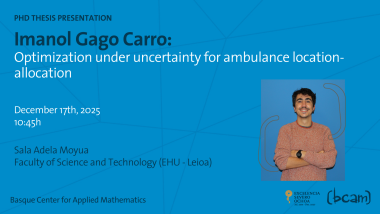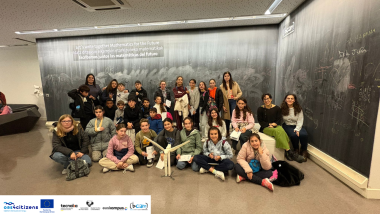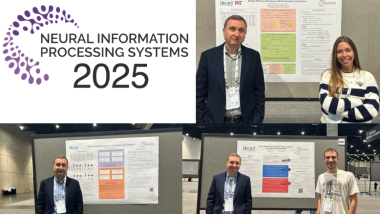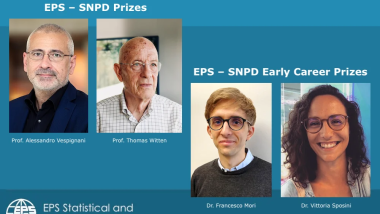BCAM researchers analyze crowd behavior, using San Mamés Stadium as a reference, to improve mobility management in mass events
-
A multidisciplinary team from the Basque Center for Applied Mathematics – BCAM has developed an innovative computational tool to study and optimize pedestrian mobility at mass events through the project M3OVE: Mathematical Modeling of Urban Mobility for the Management and Organization of Mass Events, funded by the Provincial Council of Bizkaia under its 2023 Technology Transfer Program.
-
Thanks to collaboration with Athletic Club, the research team was granted access to real data on fan entries to San Mamés Stadium and the venue’s architectural plans. Using this and the surrounding urban geometry, they created a Digital Twin of the stadium and nearby streets. This enabled a proof of concept simulating crowd behavior during matchday access at peak attendance events, including crowd management protocols used during the UEFA Europa League 2024–2025.
-
The City Council of Bilbao collaborated in the project, providing useful resources for the tool during its preliminary phase.
-
The team leading this development includes Ikerbasque Research Professor Marco Ellero (BCAM) and Dr. Dae-Jin Lee (IE University), experts in fluid simulation, stochastic modeling, applied statistics, and data visualization. They worked alongside PhD candidate Ander García and postdoctoral researchers Bruno Guerrero and Dariel Hernández (BCAM) — all specialists in complex systems modeling — as well as undergraduate students Andoni Zalaya, Rubén Peña, and June Asua from DigiPen Institute of Technology Europe–Bilbao.
A multidisciplinary team from the Basque Center for Applied Mathematics – BCAM has developed an innovative computational tool to study and optimize pedestrian mobility through the project M3OVE, funded by the Provincial Council of Bizkaia under the 2023 Technology Transfer Program.
In recent years, the growing number of large-scale events — festivals, football matches, demonstrations, or concerts — has highlighted the need for tools that can help anticipate potential bottlenecks or accidents. Overcrowding is one of the main challenges in ensuring both safety and a positive experience for attendees. In this context, understanding collective crowd behavior becomes a priority for public authorities, security forces, and event organizers.
A mathematical model serving public safety
The BCAM project combines advanced mathematical-computational modeling and statistical analysis tools to realistically simulate crowd flows in different urban scenarios. Based on a pedestrian dynamics model calibrated with empirical data, the researchers have developed a tool capable of predicting the formation of high-density areas, analyzing bottlenecks, and assessing the impact of strategically placed barriers or modified access routes.
“With this project, we aim to develop a practical tool for institutions managing mass events — not only to optimize access and evacuation flows, but also to improve the public’s experience and, above all, ensure their safety,” explains Prof. Marco Ellero, Ikerbasque Research Professor and leader of BCAM’s Computational Fluid Dynamics group.
The development team includes Prof. Marco Ellero (BCAM) and Dr. Dae-Jin Lee (IE University), supported by PhD candidate Ander García, postdoctoral researchers Bruno Guerrero and Dariel Hernández (BCAM), and undergraduate students Andoni Zalaya, Rubén Peña, and June Asua (DigiPen Institute of Technology Europe–Bilbao). Together, they bring expertise in fluid simulation, stochastic modeling, applied statistics, data visualization, and extensive experience in complex physical systems modeling.
The City Council of Bilbao also collaborated in the early stages of the project by providing valuable resources for the tool.
San Mamés: a key case study
Through collaboration with Athletic Club, the team obtained anonymized real data from stadium turnstiles recording fan entries to San Mamés. Using these data along with the stadium’s blueprints and the surrounding urban layout, they created a Digital Twin of both the venue and adjacent streets. This digital model was used to simulate fan access procedures applied during UEFA Europa League 2024–2025 matches, allowing the researchers to identify high-density areas and analyze how barrier placement affects crowd mobility.
The goal of the project is to support data-driven contingency planning and offer effective solutions that improve safety and event management in complex urban environments, minimizing the risks associated with large gatherings.
“The model allows us to simulate different scenarios — for example, what would happen if certain streets were closed, if access points were modified, or if a security perimeter were established around the stadium, as is done in European finals,” adds Prof. Ellero.
Applications beyond football
The technology developed by BCAM has broad potential applications. It can be used not only for sporting events but also for concerts, festivals, and any situation involving large crowds in confined spaces. Moreover, the tool can be applied to urban planning, enabling assessment of pedestrian behavior in areas still under construction — such as Zorrotzaurre Island in Bilbao — or improving crowd flow management in key infrastructures like metro stations, shopping centers, healthcare facilities, or urban hubs.
The team is also developing a new model to simulate the local transmission of infectious diseases, coupled with the pedestrian dynamics model. In collaboration with Galdakao-Usansolo University Hospital, they are simulating pathogen transmission scenarios, such as COVID-19 spread among healthcare workers. This extension aims to adapt the modeling approach to the specific context of local disease transmission, applicable both in hospital settings and in other enclosed environments with high human circulation.
Technology, science, and prevention
At the heart of the project lies the Social Force Model, which uses particles to simulate pedestrian dynamics. These particles are subject to three main forces: a driving force toward multiple destinations; a social repulsion force to avoid contact, and contact forces in case of collisions.
The model reproduces realistic behavioral patterns such as bottleneck formations, speed–density relationships, pedestrian evacuation flows, and lane formation in bidirectional streams. It also replicates the “faster-is-slower” phenomenon observed in evacuations — when people attempt to exit an enclosed space too quickly, the resulting pressure and pushing paradoxically slow down the overall evacuation, despite each individual trying to move faster.
Impact and future outlook
The outcome of the project is a tool designed not only to enhance safety management and contingency planning for mass events, but also to contribute to the design of smarter, more resilient, and sustainable cities by anticipating collective human behavior in public spaces.
“Understanding how people move in large crowds helps us not only prevent accidents but also design friendlier cities better adapted to the real needs of their inhabitants. Mathematics, in this sense, is a key ally,” concludes the research team.

Related news
Women in Science




